巻号一覧

39 巻, 7 号
選択された号の論文の23件中1~23を表示しています
- |<
- <
- 1
- >
- >|
Communication to the Editor
-
Tamaki Watanabe, Naoko Hara Tomioka, Shigekazu Watanabe, Yoshihiko Suz ...2016 年 39 巻 7 号 p. 1081-1084
発行日: 2016/07/01
公開日: 2016/07/01
[早期公開] 公開日: 2016/05/10ジャーナル フリー HTMLThirty minutes incubation at room temperature elevates the uric acid (UA) level of mouse blood in a test tube, and has previously been reported as “false in vitro elevation of the uric acid level.” However the UA level of human blood does not elevate using the same incubation. We clarified the mechanism of the false in vitro UA elevation using mice with highly active hypoxanthine phosphoribosyl transferase (Hprt) of B6-ChrXCMSM, a consomic mouse strain with the chromosome portion of Mus musculus morocinus in the Hprt gene site, or mice with a targeted deletion of the urate oxidase gene (Uox) (Uox-knockout (KO)). The plasma levels of UA, hypoxanthine, and xanthine, determined by HPLC, were compared with those of C57BL/6J laboratory mice used as controls. The uric acid level of Uox-KO mice was approximately 10 times higher than that of control, did not elevated after incubation in the test tube. With allopurinol, the hypoxanthine levels of B6-ChrXCMSM and Uox-KO were significantly lower than that of controls. Without allopurinol, the UA and xanthine levels of B6-ChrXCMSM were significantly lower than those of C57BL/6J controls. Even with allopurinol, the UA and xanthine levels were still significantly lower than that of controls. In conclusion, “false in vitro elevation of uric acid level” seems to be caused by low levels of erythrocyte HPRT activity and the low plasma uric acid level of laboratory mice. Graphical Abstract Fullsize Image抄録全体を表示PDF形式でダウンロード (712K) HTML形式で全画面表示
Graphical Abstract Fullsize Image抄録全体を表示PDF形式でダウンロード (712K) HTML形式で全画面表示
Regular Articles
-
Hideyuki Kushihara, Takafumi Kuzuya, Yuko Miwa, Kenta Iwasaki, Yoshihi ...2016 年 39 巻 7 号 p. 1085-1090
発行日: 2016/07/01
公開日: 2016/07/01
ジャーナル フリー HTMLCyclosporine (CSA), which is one of the substrates of ATP binding cassette subfamily B member 1 (ABCB1), is widely used as an immunosuppressant in patients undergoing transplantation. The expression level of P-glycoprotein on lymphocytes that is encoded by ABCB1 gene is considered to be one of the major causes of differences in intracellular CSA concentration. The clinical relevance of ABCB1 mRNA expression in peripheral blood was analyzed. We examined (i) the relationship between ABCB1 mRNA and the intracellular concentration of CSA in vitro, (ii) the change in long-term ABCB1 mRNA expression levels, and (iii) its association with acute rejection (AR) or cytomegalovirus (CMV) reactivation in living-donor renal transplantation. A significantly negative correlation between ABCB1 mRNA expression and intracellular CSA concentration in vitro was obtained (p<0.05). ABCB1 mRNA expression was significantly reduced (55%) 1 week after transplantation (p<0.001) and returned to the pre-transplantation level after 1 year. Although the sample size may be too small to obtain a definitive conclusion, no association was observed between ABCB1 mRNA expression levels and AR or CMV reactivation. Graphical Abstract Fullsize Image抄録全体を表示PDF形式でダウンロード (475K) HTML形式で全画面表示
Graphical Abstract Fullsize Image抄録全体を表示PDF形式でダウンロード (475K) HTML形式で全画面表示 -
Jia Zhou, Jingjing Ling, Fengfeng Ping2016 年 39 巻 7 号 p. 1091-1099
発行日: 2016/07/01
公開日: 2016/07/01
ジャーナル フリー HTMLInterferon-γ (IFN-γ) is an important cytokine which can be secreted by keratinocytes or macrophages induced by UVB irradiation in skin. Mammalian skin cells have the capability to produce and metabolize 5-hydroxytryptamine (5-HT) whose cutaneous effects are mediated by the interactions with 5-HT receptors. Treatment with 5-HT resulted in a dose-dependent increase of tyrosinase (TYR) activity and melanin contents in normal human foreskin-derived epidermal melanocytes (NHEM), while with IFN-γ a decreased effect resulted. These regulatory results were due to changes of the expression levels of microphthalmia-associated transcription factor (MITF) and its downstream TYR, tyrosinase-related protein 1 (TRP-1) and dopachrome tautomerase (DCT). We proved here that 5-HTR1A/2A participated in the regulation of melanogenesis. IFN-γ could offset the pro-melanogenesis effect of 5-HT in NHEM and the intensity of this neutralization was unanticipated below the baseline level. IFN-γ neutralized the up-regulation effect of 5-HT on MITF and downstream TYR, TRP-1 and DCT. Though functioning as 5-HT1A/2A receptor during the melanogenesis process, IFN-γ played no role in 5-HT1A/2A receptor expressions. Our results also demonstrated that the inhibition of IFN-γ was reversible after its removal. Confusingly, the effect of cross-talk between 5-HT and IFN-γ on NHEM melanogenesis was irreversible. Whether treated with 5-HT for 5 d or 12 d, the pigmentation level neither recovered after displacing the IFN-γ-containing medium. In addition, IFN-γ was able to inhibit the inductive effect of 5-HT on NHEM migration. Taken together, the suppression of IFN-γ on 5-HT-induced melanogenesis further suggests the negative role of IFN-γ in inflammation-associated pigmentary changes. Graphical Abstract Fullsize Image抄録全体を表示PDF形式でダウンロード (2302K) HTML形式で全画面表示
Graphical Abstract Fullsize Image抄録全体を表示PDF形式でダウンロード (2302K) HTML形式で全画面表示 -
Fuka Aizawa, Takashi Nishinaka, Takuya Yamashita, Kazuo Nakamoto, Yuta ...2016 年 39 巻 7 号 p. 1100-1106
発行日: 2016/07/01
公開日: 2016/07/01
ジャーナル フリー HTMLWe previously reported that levels of long-chain fatty acids (FAs) including docosahexaenoic acids (DHA) increase in the hypothalamus of inflammatory pain model mice. However, the precise mechanisms underlying the increment of free fatty acids (FFAs) in the brain during inflammation remains unknown. In this study, we characterized FFAs released by inflammatory stimulation in rat primary cultured astrocytes, and tested the involvement of phospholipase A2 (PLA2) on these mechanisms. Lipopolysaccharide (LPS) stimulation significantly increased the levels of several FAs in the astrocytes. Under these conditions, mRNA expression of cytosolic PLA2 (cPLA2) and calcium-independent PLA2 (iPLA2) in LPS-treated group increased compared with the control group. Furthermore, in the culture media, the levels of DHA and arachidonic acid (ARA) significantly increased by LPS stimuli compared with those of a vehicle-treated control group whereas the levels of saturated FAs (SFAs), namely palmitic acid (PAM) and stearic acid (STA), did not change. In summary, our findings suggest that astrocytes specifically release DHA and ARA by inflammatory conditions. Therefore astrocytes might function as a regulatory factor of DHA and ARA in the brain. Graphical Abstract Fullsize Image抄録全体を表示PDF形式でダウンロード (1086K) HTML形式で全画面表示
Graphical Abstract Fullsize Image抄録全体を表示PDF形式でダウンロード (1086K) HTML形式で全画面表示 -
Ayumu Hirata, Hiroki Funato, Megumi Nakai, Michiro Iizuka, Noriaki Abe ...2016 年 39 巻 7 号 p. 1107-1111
発行日: 2016/07/01
公開日: 2016/07/01
ジャーナル フリー HTMLWe previously prepared and pharmaceutically evaluated ginger orally disintegrating (OD) tablets, optimized the base formulation, and carried out a clinical trial in healthy adults in their 20 s and 50s to measure their effect on salivary substance P (SP) level and improved swallowing function. In this study, we conducted clinical trials using the ginger OD tablets in older people to clinically evaluate the improvements in swallowing function resulting from the functional components of the tablet. The ginger OD tablets were prepared by mixing the excipients with the same amount of mannitol and sucrose to a concentration of 1% ginger. Eighteen healthy older adult volunteers aged 63 to 90 were included in the swallowing function test. Saliva was collected before and 15 min after administration of the placebo and ginger OD tablets. Swallowing endoscopy was performed by an otolaryngologist before administration and 15 min after administration of the ginger OD tablets. A scoring method was used to evaluate the endoscopic swallowing. Fifteen minutes after taking the ginger OD tablets, the salivary SP amount was significantly higher than prior to ingestion or after taking the placebo (p<0.05). Among 10 subjects, one scored 1–3 using the four evaluation criteria. Overall, no aspiration occurred and a significant improvement in the swallowing function score was observed (p<0.05) after taking the ginger OD tablets. Our findings showed that the ginger OD tablets increased the salivary SP amount and improved swallowing function in older people with appreciably reduced swallowing function. Graphical Abstract Fullsize Image抄録全体を表示PDF形式でダウンロード (301K) HTML形式で全画面表示
Graphical Abstract Fullsize Image抄録全体を表示PDF形式でダウンロード (301K) HTML形式で全画面表示 -
Ning Wan, Yi-Yang Jia, Yi-Lin Hou, Xi-Xi Ma, Yong-Sheng He, Chen Li, S ...2016 年 39 巻 7 号 p. 1112-1120
発行日: 2016/07/01
公開日: 2016/07/01
[早期公開] 公開日: 2016/04/26ジャーナル フリー HTMLIn this work two novel cationic lipids using natural tartaric acid as linking backbone were synthesized. These cationic lipids were simply constructed by tartaric acid backbone using head group 6-aminocaproic acid and saturated hydrocarbon chains dodecanol (T-C12-AH) or hexadecanol (T-C16-AH). The physicochemical properties, gel electrophoresis, transfection activities, and cytotoxicity of cationic liposomes were tested. The optimum formulation for T-C12-AH and T-C16-AH was at cationic lipid/dioleoylphosphatidylethanolamine (DOPE) molar ratio of 1 : 0.5 and 1 : 2, respectively, and N/P charge molar ratio of 1 : 1 and 1 : 1, respectively. Under optimized conditions, T-C12-AH and T-C16-AH showed effective gene transfection capabilities, superior or comparable to that of commercially available transfecting reagent 3β-[N-(N′,N′-dimethylaminoethyl)carbamoyl]cholesterol (DC-Chol) and N-[2,3-dioleoyloxypropyl]-N,N,N-trimethylammonium chloride (DOTAP). The results demonstrated that the two novel tartaric acid-based cationic lipids exhibited low toxicity and efficient transfection performance, offering an excellent prospect as nonviral vectors for gene delivery. Graphical Abstract Fullsize Image抄録全体を表示PDF形式でダウンロード (2162K) HTML形式で全画面表示
Graphical Abstract Fullsize Image抄録全体を表示PDF形式でダウンロード (2162K) HTML形式で全画面表示 -
Yoshihiko Nakatani, Taku Amano, Hiroshi Takeda2016 年 39 巻 7 号 p. 1121-1129
発行日: 2016/07/01
公開日: 2016/07/01
ジャーナル フリー HTMLAstroglial cells have been considered to have passive brain function by helping to maintain neurons. However, recent studies have revealed that the dysfunction of such passive functions may be associated with various neuropathological diseases, such as schizophrenia, Alzheimer’s disease, amyotrophic lateral sclerosis and major depression. Corticosterone (CORT), which is often referred to as the stress hormone, is a well-known regulator of peripheral immune responses and also shows anti-inflammatory properties in the brain. However, it is still obscure how CORT affects astroglial cell function. In this study, we investigated the effects of CORT on the proliferation and survival of astroglial cells using C6 glioma cells. Under treatment with CORT for 24h, the proliferation of C6 glioma cells decreased in a dose-dependent manner. Moreover, this inhibition was diminised by treatment with mifepristone, a glucocorticoid receptor (GR) antagonist, but not by spironolactone, a mineralocorticoid receptor (MR) antagonist, and was independent of GR phosphorylation and other GR-related intracellular signaling cascades. Furthermore, it was observed that the translocation of GR from the cytosol to the nucleus was promoted by the treatment with CORT. These results indicate that CORT decreases the proliferation of C6 glioma cells by modifying the transcription of a particular gene related to cell proliferation independent of GR phosphorylation. Graphical Abstract Fullsize Image抄録全体を表示PDF形式でダウンロード (2614K) HTML形式で全画面表示
Graphical Abstract Fullsize Image抄録全体を表示PDF形式でダウンロード (2614K) HTML形式で全画面表示 -
Cho Rong Kim, Soo Jung Choi, Yoon Kyung Kwon, Jae Kyeom Kim, Youn-Jung ...2016 年 39 巻 7 号 p. 1130-1136
発行日: 2016/07/01
公開日: 2016/07/01
ジャーナル フリー HTMLThe pathogenesis of Alzheimer’s disease (AD) has been linked to the deficiency of neurotransmitter acetylcholine (ACh) in the brain, and the main treatment strategy for improving AD symptoms is the inhibition of acetylcholinesterase (AChE) activity. In the present study, we aimed to identify potent AChE inhibitors from Cinnamomum loureirii extract via bioassay-guided fractionation. We demonstrated that the most potent AChE inhibitor present in the C. loureirii extract was 2,4-bis(1,1-dimethylethyl)phenol. To confirm the antiamnesic effects of the ethanol extract of C. loureirii, mice were intraperitoneally injected with the neurotoxin trimethyltin (2.5 mg/kg) to induce cognitive dysfunction, and performance in the Y-maze and passive avoidance tests was assessed. Treatment with C. loureirii extract significantly improved performance in both behavioral tests, suggesting that this extract may be neuroprotective and therefore beneficial in preventing or ameliorating the degenerative processes of AD, potentially by restoring cholinergic function. Graphical Abstract Fullsize Image抄録全体を表示PDF形式でダウンロード (684K) HTML形式で全画面表示
Graphical Abstract Fullsize Image抄録全体を表示PDF形式でダウンロード (684K) HTML形式で全画面表示 -
Hiroko Makihara, Yuka Koike, Masatomi Ohta, Emi Horiguchi-Babamoto, Ma ...2016 年 39 巻 7 号 p. 1137-1143
発行日: 2016/07/01
公開日: 2016/07/01
ジャーナル フリー HTML
電子付録Visceral obesity induces the onset of metabolic disorders such as insulin resistance and diabetes mellitus. Adipose tissue is considered as a potential pharmacological target for treating metabolic disorders. The fruit of Terminalia bellirica is extensively used in Ayurvedic medicine to treat patients with diseases such as diabetes mellitus. We previously investigated the effects of a hot water extract of T. bellirica fruit (TB) on obesity and insulin resistance in spontaneously obese type 2 diabetic mice. To determine the active ingredients of TB and their molecular mechanisms, we focused on adipocyte differentiation using mouse 3T3-L1 cells, which are widely used to study adipocyte physiology. We show here that TB enhanced the differentiation of 3T3-L1 cells to mature adipocytes and that one of the active main components was identified as gallic acid. Gallic acid (10–30 µM) enhanced the expression and secretion of adiponectin via adipocyte differentiation and also that of fatty acid binding protein-4, which is the target of peroxisome proliferator-activated receptor gamma (PPARγ), although it does not alter the expression of the upstream genes PPARγ and CCAAT enhancer binding protein alpha. In the PPARγ ligand assay, the binding of gallic acid to PPARγ was undetectable. These findings indicate that gallic acid mediates the therapeutic effects of TB on metabolic disorders by regulating adipocyte differentiation. Therefore, TB shows promise as a candidate for preventing and treating patients with metabolic syndrome. Graphical Abstract Fullsize Image抄録全体を表示PDF形式でダウンロード (2890K) HTML形式で全画面表示
Graphical Abstract Fullsize Image抄録全体を表示PDF形式でダウンロード (2890K) HTML形式で全画面表示 -
Masashi Kitamura, Masako Aragane, Kou Nakamura, Kazuhito Watanabe, Yoh ...2016 年 39 巻 7 号 p. 1144-1149
発行日: 2016/07/01
公開日: 2016/07/01
[早期公開] 公開日: 2016/04/27ジャーナル フリー HTMLIn many parts of the world, the possession and cultivation of Cannabis sativa L. are restricted by law. As chemical or morphological analyses cannot identify the plant in some cases, a simple yet accurate DNA-based method for identifying C. sativa is desired. We have developed a loop-mediated isothermal amplification (LAMP) assay for the rapid identification of C. sativa. By optimizing the conditions for the LAMP reaction that targets a highly conserved region of tetrahydrocannabinolic acid (THCA) synthase gene, C. sativa was identified within 50 min at 60–66°C. The detection limit was the same as or higher than that of conventional PCR. The LAMP assay detected all 21 specimens of C. sativa, showing high specificity. Using a simple protocol, the identification of C. sativa could be accomplished within 90 min from sample treatment to detection without use of special equipment. A rapid, sensitive, highly specific, and convenient method for detecting and identifying C. sativa has been developed and is applicable to forensic investigations and industrial quality control.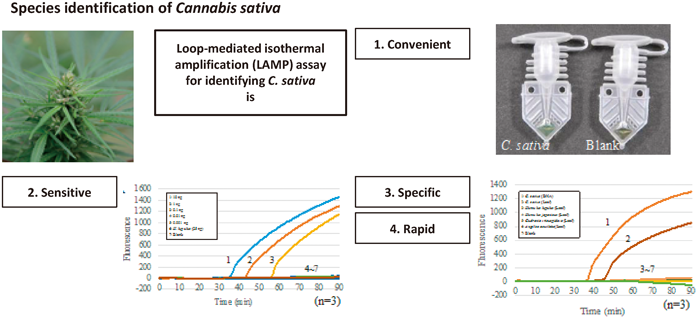 Graphical Abstract Fullsize Image抄録全体を表示PDF形式でダウンロード (1891K) HTML形式で全画面表示
Graphical Abstract Fullsize Image抄録全体を表示PDF形式でダウンロード (1891K) HTML形式で全画面表示 -
Vishwa Deepak, Abe Kasonga, Marlena Cathorina Kruger, Magdalena Coetze ...2016 年 39 巻 7 号 p. 1150-1158
発行日: 2016/07/01
公開日: 2016/07/01
[早期公開] 公開日: 2016/05/10ジャーナル フリー HTMLBone is a dynamic tissue that undergoes continuous remodeling coupled with the action of osteoblasts and osteoclasts. Osteoclast activity is elevated during osteoporosis and periodontitis resulting in excessive loss of trabecular and alveolar bone. Osteoclasts are formed in an inflammatory response to cytokine production receptor activator of nuclear factor-kappaB (NF-κB) ligand (RANKL) and bacterial challenge lipopolysaccharide (LPS). Carvacrol, a monoterpenic phenol present in Origanum vulgare and Thymus vulgaris, is a natural compound with known medicinal properties. We investigated the effects of carvacrol on osteoclast formation induced by RANKL and LPS. Carvacrol suppressed RANKL-induced formation of tartrate resistant acid phosphatase (TRAP)-positive multinucleated cells in RAW264.7 macrophages and human CD14+ monocytes. Furthermore, carvacrol inhibited LPS-induced osteoclast formation in RAW264.7 macrophages. Investigation of the underlying molecular mechanisms revealed that carvacrol downregulated RANKL-induced NF-κB activation in a dose-dependent manner. Furthermore, the suppression of NF-κB activation correlated with inhibition of inhibitor of kappaB (IκB) kinase (IKK) activation and attenuation of inhibitor of NF-κB (IκBa) degradation. Carvacrol potentiated apoptosis in mature osteoclasts by caspase-3 activation and DNA fragmentation. Moreover, carvacrol did not affect the viability of proliferating MC3T3-E1 osteoblast-like cells. Collectively, these results demonstrate that carvacrol mitigates osteoclastogenesis by impairing the NF-κB pathway and induction of apoptosis in mature osteoclasts. Graphical Abstract Fullsize Image抄録全体を表示PDF形式でダウンロード (4446K) HTML形式で全画面表示
Graphical Abstract Fullsize Image抄録全体を表示PDF形式でダウンロード (4446K) HTML形式で全画面表示 -
Mohamed Gamal Ewees, Basim Anwar Shehata Messiha, Ali Ahmed Abo-Saif, ...2016 年 39 巻 7 号 p. 1159-1166
発行日: 2016/07/01
公開日: 2016/07/01
ジャーナル フリー HTMLCoenzyme Q10 (Co-Q10) is a vitamin-like supplement which appears to be safe, with minimal side effects and low drug interaction potential. Co-Q10 is used in the treatment of a variety of disorders related primarily to suboptimal cellular energy metabolism and oxidative injury. Studies supporting the efficacy of Co-Q10 appear most promising for a variety of diseases, including ulcerative colitis (UC). The present investigation aims to elucidate the possible protective effects of Co-Q10 against UC, as induced by the administration of iodoacetamide to adult male albino rats. In our study, Co-Q10 showed potent anti-oxidant and anti-inflammatory activities through a significant increase in catalase activity and glutathione content. In addition, it significantly decreased myeloperoxidase activity, malondialdehyde content and nitrate/nitrite production. These results suggest that Co-Q10 protects against UC in rats via anti-oxidant and anti-inflammatory potentials, and therefore seems promising for use in further clinical trials. Graphical Abstract Fullsize Image抄録全体を表示PDF形式でダウンロード (1631K) HTML形式で全画面表示
Graphical Abstract Fullsize Image抄録全体を表示PDF形式でダウンロード (1631K) HTML形式で全画面表示 -
Yoshihiko Ito, Michishi Kashiwabara, Akira Yoshida, Eriko Hikiyama, Sa ...2016 年 39 巻 7 号 p. 1167-1171
発行日: 2016/07/01
公開日: 2016/07/01
ジャーナル フリー HTMLSolifenacin is an antimuscarinic agent used to treat symptoms of overactive bladder. Pharmacologically significant amounts of solifenacin were excreted in the urine of humans taking a clinical dose of this drug. The aim of this study is to measure muscarinic receptor binding in the bladder urothelium and detrusor muscles of rats following the intravesical instillation of solifenacin. Muscarinic receptors were measured by radioreceptor assay using [N-methyl-3H]scopolamine methyl chloride ([3H]NMS), a selective radioligand of muscarinic receptors. Solifenacin showed concentration-dependent inhibition of specific [3H]NMS binding in the bladder urothelium and detrusor muscle of rats, with no significant difference in Ki values or Hill coefficients between these tissues. Following the intravesical instillation of solifenacin, there was significant muscarinic receptor binding (increase in Kd for specific [3H]NMS binding) in the bladder urothelium and detrusor muscle of rats. Similar bladder muscarinic receptor binding was observed by the intravesical instillation of oxybutynin, but not with trospium. In conclusion, the present study has demonstrated that solifenacin binds muscarinic receptors not only in the detrusor muscle but also in the bladder urothelium with high affinity. These bladder muscarinic receptors may be significantly affected by solifenacin excreted in the urine. Graphical Abstract Fullsize Image抄録全体を表示PDF形式でダウンロード (342K) HTML形式で全画面表示
Graphical Abstract Fullsize Image抄録全体を表示PDF形式でダウンロード (342K) HTML形式で全画面表示 -
Keiichi Motoyama, Yuki Tanida, Kyona Hata, Tomoya Hayashi, Irhan Ibrah ...2016 年 39 巻 7 号 p. 1172-1178
発行日: 2016/07/01
公開日: 2016/07/01
[早期公開] 公開日: 2016/05/10ジャーナル フリー HTMLThe goal of this study was to investigate the topical anti-inflammatory effects of the megamolecular polysaccharide sacran extracted from cyanobacterium Aphanothece sacrum using various inflammatory animal models. Sacran showed potent anti-inflammatory effects with optimum effective concentrations at 0.01 and 0.05% (w/v). Sacran markedly inhibited paw swelling and neutrophil infiltration in carrageenan-induced rat paw edema. Additionally, 6,7-dimethoxy-1-methyl-2(1H)-quinoxalinone-3-propionyl-carboxylic acid (DMEQ)-labeled sacran had the ability to penetrate carrageenan-induced rat paw skin rather than normal skin. Also, sacran significantly suppressed kaolin-induced and dextran-induced rat paw edema throughout the duration of the study. Furthermore, sacran significantly suppressed 12-O-tetradecanoylphorbol-13-acetate (TPA)-induced mouse ear edema and mRNA expression levels of cyclooxygenase (COX)-2 as well as pro-inflammatory cytokines such as tumor necrosis factor (TNF)-α, interleukin (IL)-1β, and IL-6. Safety of sacran solution was verified by negligible cytotoxicity in HaCaT cells. These results suggest that sacran may be useful as a therapeutic agent against inflammatory skin diseases with no life-threatening adverse effects. Graphical Abstract Fullsize Image抄録全体を表示PDF形式でダウンロード (2137K) HTML形式で全画面表示
Graphical Abstract Fullsize Image抄録全体を表示PDF形式でダウンロード (2137K) HTML形式で全画面表示 -
Kosuke Saito, Keiko Maekawa, Jason M. Kinchen, Rieko Tanaka, Yuji Kuma ...2016 年 39 巻 7 号 p. 1179-1186
発行日: 2016/07/01
公開日: 2016/07/01
ジャーナル フリー HTML
電子付録Serum metabolites can reflect the diffusion/export of biochemicals from various organs. They can serve as biomarkers related to diseases and therapeutic efficacy/toxicity. While studies in Caucasians suggested that subject gender and age can affect circulating metabolite profiles, the Japanese population has not been surveyed. Our objective was to delineate gender- and age-associated differences in serum metabolite profiles among Japanese populations. Using a mass spectrometry-based global metabolomics approach, 516 endogenous metabolites were detected in sera from Japanese individuals. The principal component analysis identified gender as the primary component, followed by age, suggesting that these two criteria were key contributors to variations in the dataset. Gender-associated differences were observed in 31 and 25% of metabolites in the young (age 25–35) and old (ages 55–65) populations, respectively, in redox homeostasis, and in steroid and purine nucleotide metabolism pathways. Age-associated differences were observed in 24 and 23% of metabolites in men and women, respectively. No pathway was commonly highlighted. Thus, gender and age impact on metabolite profiles in the Japanese population. Our results provide useful information to explore biomarkers for clinical applications in the Japanese population and to assess the applicability of known biomarkers identified in other populations to the Japanese population.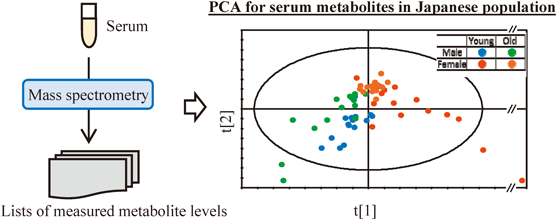 Graphical Abstract Fullsize Image抄録全体を表示PDF形式でダウンロード (1013K) HTML形式で全画面表示
Graphical Abstract Fullsize Image抄録全体を表示PDF形式でダウンロード (1013K) HTML形式で全画面表示 -
Noriko Iwamoto, Megumi Takanashi, Akinobu Hamada, Takashi Shimada2016 年 39 巻 7 号 p. 1187-1194
発行日: 2016/07/01
公開日: 2016/07/01
[早期公開] 公開日: 2016/04/28ジャーナル フリー HTML
電子付録Presently, monoclonal antibodies (mAbs) therapeutics have big global sales and are starting to receive competition from biosimilars. We previously reported that the nano-surface and molecular-orientation limited (nSMOL) proteolysis which is optimal method for bioanalysis of antibody drugs in plasma. The nSMOL is a Fab-selective limited proteolysis, which utilize the difference of protease nanoparticle diameter (200 nm) and antibody resin pore diameter (100 nm). In this report, we have demonstrated that the full validation for chimeric antibody Rituximab bioanalysis in human plasma using nSMOL proteolysis. The immunoglobulin fraction was collected using Protein A resin from plasma, which was then followed by the nSMOL proteolysis using the FG nanoparticle-immobilized trypsin under a nondenaturing condition at 50°C for 6 h. After removal of resin and nanoparticles, Rituximab signature peptides (GLEWIGAIYPGNGDTSYNQK, ASGYTFTSYNMHWVK, and FSGSGSGTSYSLTISR) including complementarity-determining region (CDR) and internal standard P14R were simultaneously quantified by multiple reaction monitoring (MRM). This quantification of Rituximab using nSMOL proteolysis showed lower limit of quantification (LLOQ) of 0.586 µg/mL and linearity of 0.586 to 300 µg/mL. The intra- and inter-assay precision of LLOQ, low quality control (LQC), middle quality control (MQC), and high quality control (HQC) was 5.45–12.9% and 11.8, 5.77–8.84% and 9.22, 2.58–6.39 and 6.48%, and 2.69–7.29 and 4.77%, respectively. These results indicate that nSMOL can be applied to clinical pharmacokinetics study of Rituximab, based on the precise analysis. Graphical Abstract Fullsize Image抄録全体を表示PDF形式でダウンロード (998K) HTML形式で全画面表示
Graphical Abstract Fullsize Image抄録全体を表示PDF形式でダウンロード (998K) HTML形式で全画面表示 -
Masayuki Maeda, Hisashi Shoji, Tetsuro Shirakura, Takahiro Takuma, Kaz ...2016 年 39 巻 7 号 p. 1195-1200
発行日: 2016/07/01
公開日: 2016/07/01
ジャーナル フリー HTMLIt is well known that methicillin-resistant Staphylococcus aureus (MRSA) produces many virulence factors, such as hemolysins, leukocidins, proteases, enterotoxins, exfoliative toxins, and immune-modulatory factors. The aim of study was to identify staphylococcal pathogenicity that may affect the prognosis of patients with MRSA bacteremia. We obtained 149 MRSA strains from blood cultures between January 2009 and December 2014 in our institution. We collected information on patient characteristics, laboratory data, staphylococcal toxin genes, and susceptibility of the strain toward anti-MRSA agent and analyzed them as factors contributing to 30-d mortality. The “survival” and “dead” groups consisted of 103 and 46 patients, respectively. Multiple logistic regression analysis showed a four-fold increase in the risk of mortality in patients exhibiting isolated MRSA with staphylococcal enterotoxins (SEs) genes as well as toxic shock syndrome toxin-1 (TSST-1) genes [odds ratio: 3.89; 95% confidence interval: 1.20–12.60; p=0.024]. Kaplan–Meier analysis also showed significantly higher mortality in patient with isolated MRSA with SEs and TSST-1 genes. After adjusting for confounders, the coexistence of SEs and TSST-1 were independently associated with the 30-d mortality compared with treatment and susceptibility. The coexistence of superantigenic toxin genes greatly affects the clinical course and prognosis of patients with MRSA bacteremia.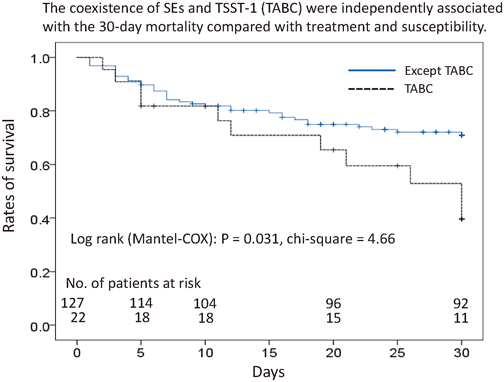 Graphical Abstract Fullsize Image抄録全体を表示PDF形式でダウンロード (464K) HTML形式で全画面表示
Graphical Abstract Fullsize Image抄録全体を表示PDF形式でダウンロード (464K) HTML形式で全画面表示 -
Kazuhiko Matsuo, Sachiko Hirobe, Naoki Okada, Shinsaku Nakagawa2016 年 39 巻 7 号 p. 1201-1205
発行日: 2016/07/01
公開日: 2016/07/01
ジャーナル フリー HTMLNanomaterials (NMs) are defined as those which have nanostructured components less than 100 nm in diameter. They are widely used in various fields such as medicine, cosmetics, and the food industry. However, the toxicological effects of NMs are less well understood than their applications. In particular, the skin is exposed to the environment at all times, so is easily influenced by NMs. In this study, we investigated the skin permeability and toxicological properties of well-dispersed amorphous silica particles with diameters ranging from 70 to 1000 nm, to aid in the safe application of NMs. Amorphous silica particles of 70 nm in size (nSP70) penetrated the living epidermis, following pretreatment with acetone/diethyl ether to improve skin permeation. The application of unmodified nSP70, carboxyl group-modified nSP70, or amino group-modified nSP70 for long durations caused little skin irritation at the application site. Under the present experimental conditions, few adverse systemic effects were evident from blood tests and histopathologic examination. These results suggest that decreasing particle size increases the NMs skin permeability, but remarkably little corresponding skin irritation is observed.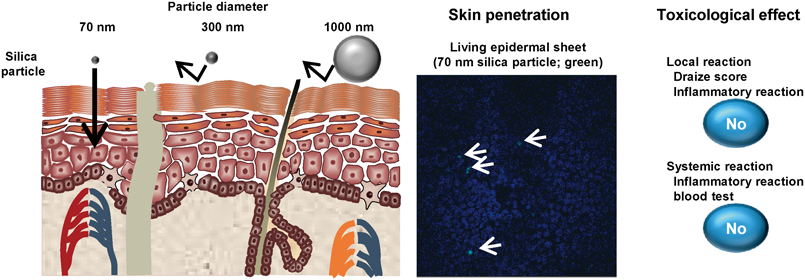 Graphical Abstract Fullsize Image抄録全体を表示PDF形式でダウンロード (669K) HTML形式で全画面表示
Graphical Abstract Fullsize Image抄録全体を表示PDF形式でダウンロード (669K) HTML形式で全画面表示
Notes
-
Seiji Tokumoto, Naruhito Higo, Hiroaki Todo, Kenji Sugibayashi2016 年 39 巻 7 号 p. 1206-1210
発行日: 2016/07/01
公開日: 2016/07/01
ジャーナル フリー HTMLIn vitro permeation studies of mannitol were conducted across excised hairless mouse skin to determine and compare the enhancing effect of electroporation (EP) or sonophoresis (SP) combined with iontophoresis (IP) on the electroosmotic flow, and to analyze the enhancement mechanism of these combined methods. Mannitol flux was utilized as an index for the electroosmotic flow due to its low molecular weight and no electrorepulsion effect. The combination of SP and IP (SP/IP) resulted in an apparent increase of electroosmotic flow (no effect was sometimes observed by SP/IP), while that of EP and IP (EP/IP) had no synergistic enhancing effect on the electroosmosis. Next, the combined effect of tape-stripping (TS) and IP (TS/IP) was examined in a similar manner to clarify the difference between the SP/IP and EP/IP effects on electroosmosis. When the TS number increased from 0 to 3, the electroosmotic flow increased with the TS number. However, no further increase was observed when the TS number became more than 3, and the flow started to decrease when the TS number became 5. The electric charge of the skin surface was then measured after SP or TS application. When SP was applied, the skin surface charge became much more negative and the electroosmotic flow by SP/IP was markedly increased. Thus, an increase in the electroosmotic flow across the skin during IP application can be obtained not by EP and TS, but by SP. The combined use of SP and IP is a promising means for the enhanced skin delivery of non-electrolyte drugs.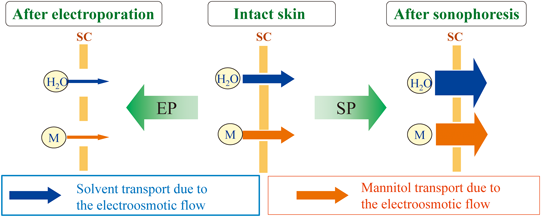 Graphical Abstract Fullsize Image抄録全体を表示PDF形式でダウンロード (582K) HTML形式で全画面表示
Graphical Abstract Fullsize Image抄録全体を表示PDF形式でダウンロード (582K) HTML形式で全画面表示 -
Tamaki Kurosawa, Atsushi Yamada, Dai Suzuki, Naoko Morimura, Yoshiyuki ...2016 年 39 巻 7 号 p. 1211-1215
発行日: 2016/07/01
公開日: 2016/07/01
ジャーナル フリー HTMLNephronectin (Npnt), known to be a ligand of integrin α8β1, plays important roles in the development and function of various tissues, including those of the kidneys, liver, bones, and muscles. In previous studies, we showed that the expression of Npnt mRNA was regulated by various cytokines, including transforming growth factor-β (TGF-β), tumor necrosis factor-α (TNF-α), and oncostatin M (OSM), and that over-expression of Npnt enhanced osteoblast differentiation. In this study, we found that bone morphogenic protein-2 (BMP-2), known as an osteogenesis inducing cytokine, strongly up-regulated the expression of Npnt mRNA in a murine skeletal muscle cell line (C2C12) via the BMP-SMAD signaling pathway. Graphical Abstract Fullsize Image抄録全体を表示PDF形式でダウンロード (1288K) HTML形式で全画面表示
Graphical Abstract Fullsize Image抄録全体を表示PDF形式でダウンロード (1288K) HTML形式で全画面表示 -
Shogo Hamaguchi, Koh Hikita, Yusuke Tanaka, Yayoi Tsuneoka, Iyuki Name ...2016 年 39 巻 7 号 p. 1216-1219
発行日: 2016/07/01
公開日: 2016/07/01
ジャーナル フリー HTMLThe effects of mechanical stretch on the automaticity of the guinea pig isolated pulmonary vein preparations were studied in microelectrode experiments. The application of cumulative mechanical stretch to the preparations resulted in increases in the firing rate of spontaneous electrical activity in the myocardial layer. This effect was significantly inhibited by stretch-activated channel blockers such as gadolinium or streptomycin. These results suggest that acute mechanical stretch enhances the automaticity of the guinea pig pulmonary vein myocardium through the opening of the stretch-activated channels.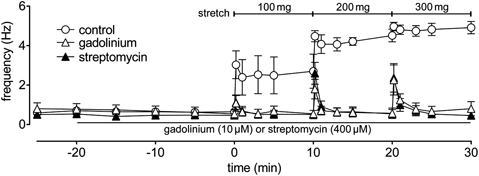 Graphical Abstract Fullsize Image抄録全体を表示PDF形式でダウンロード (423K) HTML形式で全画面表示
Graphical Abstract Fullsize Image抄録全体を表示PDF形式でダウンロード (423K) HTML形式で全画面表示 -
Katsuhiko Matsui, Saki Tamai, Reiko Ikeda2016 年 39 巻 7 号 p. 1220-1223
発行日: 2016/07/01
公開日: 2016/07/01
ジャーナル フリー HTMLIt is well known that Langerhans cells (LCs) work as the primary orchestrators in the polarization of the immune milieu towards a T helper type 1 (Th1) or T helper type 2 (Th2) response. In this study, we investigated the effects of tacrolimus and betamethasone, each used as topical applications in atopic dermatitis (AD), on Th2 cell development mediated by LCs. LC-like dendritic cells (LDCs) were generated from mouse bone marrow cells and used as substitutes for LCs. Mice were primed with ovalbumin (OVA) peptide-pulsed LDCs, which had been treated with tacrolimus or betamethasone, via the hind footpad. After 5 d, the cytokine response in the popliteal lymph nodes was investigated by enzyme-linked immunosorbent assay. The expression of cell surface molecules on LDCs was investigated via reverse transcriptase polymerase chain reaction. Administration of OVA peptide-pulsed LDCs, which had been treated with betamethasone, inhibited Th2 cell development, as represented by the down-regulation of interleukin-4 production, and also inhibited Th1 cell development, represented by the down-regulation of interferon-γ production. However, tacrolimus-treated LDCs did not induce such inhibition of the development of Th1 and Th2 cells. The inhibition of Th1 and Th2 cell development was associated with the suppression of CD40 and T-cell immunoglobulin, and mucin domain-containing protein (TIM)-4 expression, respectively, in LDCs. These results suggest that the topical application of betamethasone to skin lesions of patients with AD acts on epidermal LCs, and may inhibit the development of Th2 cells, thus being of benefit for the control of AD. Graphical Abstract Fullsize Image抄録全体を表示PDF形式でダウンロード (681K) HTML形式で全画面表示
Graphical Abstract Fullsize Image抄録全体を表示PDF形式でダウンロード (681K) HTML形式で全画面表示 -
Keisuke Nishino, Keisuke Tanamachi, Yuto Nakanishi, Shunta Ide, Shuji ...2016 年 39 巻 7 号 p. 1224-1230
発行日: 2016/07/01
公開日: 2016/07/01
[早期公開] 公開日: 2016/05/03ジャーナル フリー HTMLRadiosensitizers are used in cancer therapy to increase the γ-irradiation susceptibility of cancer cells, including radioresistant hypoxic cancer cells within solid tumors, so that radiotherapy can be applied at doses sufficiently low to minimize damage to adjacent normal tissues. Radiation-induced DNA damage is repaired by multiple repair systems, and therefore these systems are potential targets for radiosensitizers. We recently reported that the transient receptor potential vanilloid type 1 (TRPV1) channel is involved in early responses to DNA damage after γ-irradiation of human lung adenocarcinoma A549 cells. Therefore, we hypothesized that TRPV1 channel inhibitors would have a radiosensitizing effect by blocking repair of radiation-induced cell damage. Here, we show that pretreatment of A549 cells with the TRPV1 channel inhibitors capsazepine, AMG9810, SB366791 and BCTC suppressed the γ-ray-induced activation of early DNA damage responses, i.e., activation of the protein kinase ataxia-telangiectasia mutated (ATM) and accumulation of p53-binding protein 1 (53BP1). Further, the decrease of survival fraction at one week after γ-irradiation (2.0 Gy) was enhanced by pretreatment of cells with these inhibitors. On the other hand, inhibitor pretreatment did not affect cell viability, the number of apoptotic or necrotic cells, or DNA synthesis at 24 h after irradiation. These results suggest that inhibition of DNA repair by TRPV1 channel inhibitors in irradiated A549 cells caused gradual loss of proliferative ability, rather than acute facilitation of apoptosis or necrosis. TRPV1 channel inhibitors could be novel candidates for radiosensitizers to improve the efficacy of radiation therapy, either alone or in combination with other types of radiosensitizers.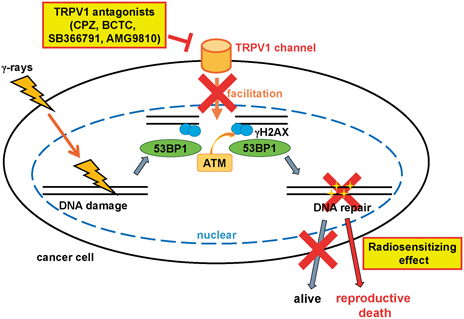 Graphical Abstract Fullsize Image抄録全体を表示PDF形式でダウンロード (3309K) HTML形式で全画面表示
Graphical Abstract Fullsize Image抄録全体を表示PDF形式でダウンロード (3309K) HTML形式で全画面表示
- |<
- <
- 1
- >
- >|